How to install a floor-standing air conditioner: recommendations for installing a portable model
Air conditioners significantly improve living conditions both in the city and beyond: on hot summer days they turn stuffy “boxes” into cool, cozy housing, and in winter they heat the air in rooms to a comfortable temperature.
Mobile climate control equipment is a separate category. Unlike systems with wall-mounted and remote units, it is not tied to a specific location, but is simply installed on the floor in a convenient area for a while.
In this article, we will look in detail at how to install a floor air conditioner so that it works properly and copes 100% with its tasks. And if you want to connect the mobile unit yourself, we will tell you how best to route the air duct outside the room.
The content of the article:
What are the advantages of mobile technology?
The question immediately arises: is this bulky floor-standing equipment really necessary when it is possible to buy a traditional split system that is more familiar to use?
Floor-standing monoblocks are classified as mobile equipment, that is, equipment that can be moved from place to place at will - moved from the living room to the bedroom, and, if necessary, taken to the dacha.

The units are attractive for those who like to change their surroundings, but at the same time live in the most comfortable conditions. Here are the 4 main qualities that regular users positively appreciated in floor-standing models:
As you can see, floor-standing monoblocks are in some ways better than split systems, and to install a home mobile air conditioner you do not need to drill into the walls and install brackets from the outside.Servicing the unit also takes little time, and its cost is no more expensive than alternative models.

If you choose floor-standing equipment, carefully read the next section to become better acquainted with installation nuances. Knowing how to properly install a mobile air conditioner, you can ensure a comfortable indoor microclimate without the help of specialists.
Installation instructions for floor air conditioner
The main difficulty in installation is the removal of the air duct outside the room. If you want to quickly put the air conditioner into operation, then you need to take care of installing a sufficiently voluminous corrugated pipe in advance.
We will provide options for arranging a hole in a wall or window below, and your task is to choose the least expensive and most convenient solution.
Stage #1 – selection of installation location
But first you need to choose the most suitable location for installation. There are two important points to consider here:
- The air outlet hose is limited in length, so the unit must be placed as close as possible to the outlet - that is, to a window, balcony, etc.
- The power cord is also usually a standard length of 1.8 m, so there should be an outlet nearby.
You won’t be able to place a candy bar anywhere – in a free corner, in the center of the room. The fact is that it is impossible to lengthen the electrical cord or air duct due to both safety requirements and technical standards.
If you manage to somehow increase the length of the corrugated duct, then you will face another problem - reduced productivity. And there is no need for useless equipment in the house.

Another important point is a smooth and solid base. In old houses there is a sloping floor, it will have to be leveled. To do this, it is not necessary to sort out the boards or do a cement fill; you can lay sheets of gypsum fiber board or thick plywood on top of the existing flooring.
Stage #2 - bringing the air duct to the street
One of the disadvantages of floor-standing air conditioners with an air duct is precisely this very duct - a thick corrugated pipe, one end of which is integrated into the body of the unit, and the other must be independently brought outside.
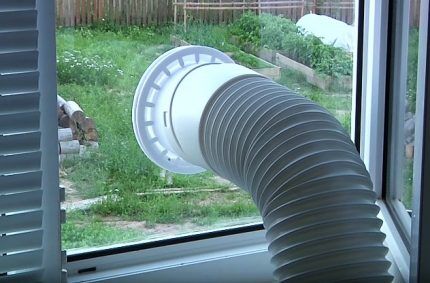
We offer the most successful, in our opinion, option, thanks to which two main goals can be achieved:
- ensure the exhaust of heated air to the outside;
- maintain an attractive window design.
As a result of the work done, you will be able to open the window sash while the air conditioner is operating and connect the air duct to a frame with plexiglass inserted like a mosquito net. Plexiglas transmits light well and has the strength necessary to firmly fix the pipe.
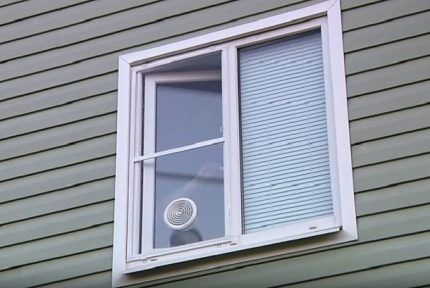
All work can be done independently. If you don’t find a tool, you can buy it, ask friends or rent it.
You will need:
Elements for fastening the air duct - strip, diffuser or adapter - must be made of more elastic and lightweight plastic; metal fittings are not suitable.
You will also need:
- construction tape;
- long metal ruler;
- pencil or marker;
- construction knife;
- sealant;
- cleaner;
- sandpaper.
Prepare sponges, rags, containers with water - everything you need to clean and degrease materials.
Sequencing:
Step #1 – cut out a piece of plexiglass to fit the frame.
First, we measure the length and width of the frame with the mosquito net, then transfer the dimensions to the plexiglass and cut out a piece.
Corners will later be attached to the edges of the frame to secure it to the window, so the glass should be slightly smaller than the frame. To find out how much, we apply the corners to the edges of the frame and make the same indentations on the glass.
To cut a piece of plexiglass, you can use an aluminum profile: apply it to the drawn line and draw it several times with a construction knife. Then simply bend along the cut line.
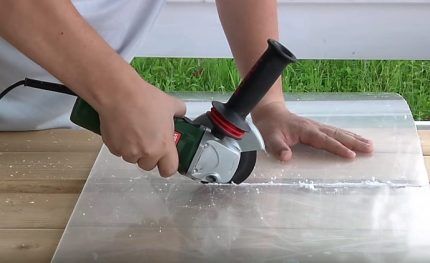
Uneven or melted edges of the finished rectangle must be trimmed with a knife or sanded with fine sandpaper.
Step #2 – cut a round hole for the air duct.
We determine the place where the hole will be located - this is the lower part of the frame, that is, approximately 15 cm from the lower edge of the plexiglass sheet. We apply the narrow part of the diffuser and outline it with a marker or knife. For cutting, we use a jigsaw or a homemade soldering iron.
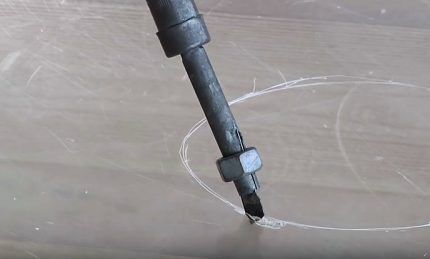
Having cut the circle to the end, we squeeze out the circle and get a hole of the required diameter. We clean the edges with a knife or sandpaper.
Step #3 – attach the plexiglass to the mosquito net frame.
It is important to maintain consistency here: first fix the glass, and then remove the mesh and the fastening rubber cord, otherwise the frame will lose stability or simply fall apart into separate elements.
For gluing it is best to use a sealant, but first you need to degrease the frame.

Apply alcohol to a cloth and wipe the frame around the perimeter. The edges of the glass can be sanded to increase adhesion.
Then we squeeze out a transparent universal sealant using a construction “gun” and apply plexiglass. First remove the protective film from the glass - until this moment it is better not to touch it.
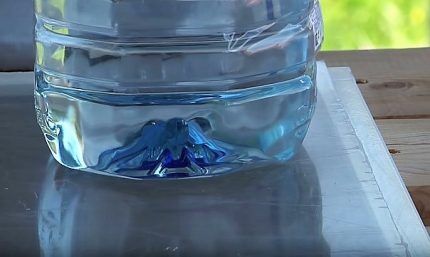
After the sealant has dried, you can remove the mosquito net. First, carefully remove the rubber cord, then pull out the mesh and insert the cord back. This is necessary to secure the plastic “ear” holders located at the edges of the frame.
If you think that the cord is not needed, remove it along with the mesh, and glue the “ears” with sealant.
Step #4 – insert the diffuser into the hole and fix it.
First we disassemble the diffuser into several parts, we get a pipe section, a grille, a mesh and a locking element in the form of a circle with “tongues”. First, insert a plastic tube, then attach a small mosquito net to the wider end, twist the grille, and put on a locking circle on the other side.
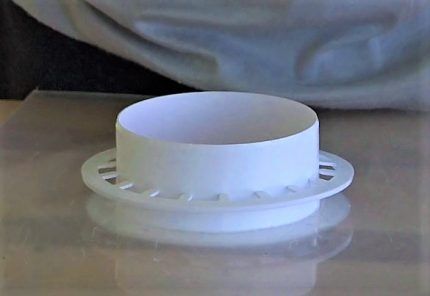
That's it, the frame with a designed hole for attaching the air duct is ready. All that remains is to open the sash and insert it into the window to check the operation. If you have successfully removed the corrugation of the mobile air conditioner, consider that the installation was a success.
Stage #3 - connecting power supply
A power outlet is required for the air conditioner to operate. The main thing is not to overload the electrical wiring if it is not designed for the installation of powerful equipment. Manufacturers do not insist on providing grounding or installing a separate circuit breaker, but the presence of an RCD is usually specified in the instructions.
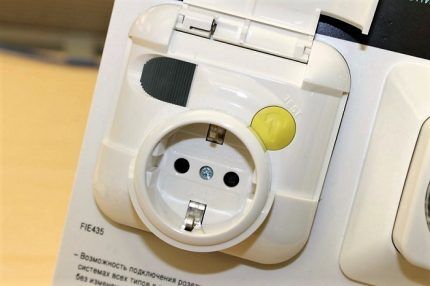
The socket should be located close to the unit, and therefore from the window. The use of extension cords, filters and other similar electrical equipment is not recommended.
General requirements for electrical installation:
- Use only certified equipment and cables.
- Do not use the air conditioner if the insulation on the power cord is damaged.
- Before any repair or maintenance work, disconnect the unit from the power supply.
- Do not expose the cabinet to water, such as rain from a window.
Some air conditioners become hot when operating at full power, so make sure that children and animals do not approach the switched on devices. In case of any emergency situations - smoke from the unit, a burning smell, leakage - immediately disconnect it from the network.
Stage #4 – testing and operating rules
The first switching on should be done only after the air duct has been brought out. You also need to make sure that the electrical network is working properly.
Procedure:
- We check the tightness of the corrugated pipe connection.
- Insert the plug into the socket.
- Press the key or the “On” button.
- Select the operating mode, temperature, fan speed.
- Click the “Start” button.
Make sure doors and windows are closed. After some time, you should feel a change in the air temperature in the room. If this does not happen, check whether you have selected the correct operating mode. In case of difficulty, call the service center.

To care for the case, use soft cloths and sponges, only neutral detergents that cannot scratch the plastic or rub off the gloss. Clean the grill with a soft brush.
Remove and wash the filter from time to time. The recommended interval is every 3 months. Use only clean water and mild alcohol- and acid-free detergents.
As the pan fills, drain the condensate. To do this, you need to remove the plug from the hose and lower its end into the container. Usually little condensation accumulates, since most of it evaporates naturally.
Other corrugation connection options
We examined in detail the best option for venting the air duct - through a hole in the window.
But there are other solutions. All of them are less successful, and now we will explain why:
- Exiting the corrugation into a window, transom or ajar window.This is often done by everyone who does not get around to equipping a more acceptable unit. Disadvantages - the heated air immediately returns back into the room, the efficiency of the unit decreases.
- The air duct exits through the balcony door. A bad option if the balcony is glazed; if not, the disadvantages are the same as in the solution with a window.
- Connecting a pipe to a hole knocked in the wall. An acceptable option if you ensure maximum thermal insulation.
The last solution is suitable if you use a mobile air conditioner constantly.
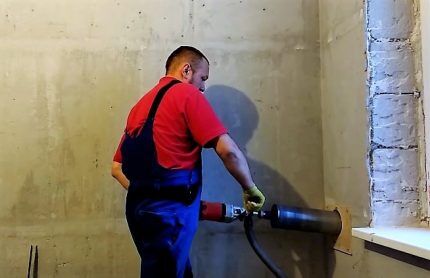
When the air conditioner is turned off, the hole is closed. You can use a “plug” made of insulation, or you can install a replacement - a ventilation valve.
In private houses, sometimes there are windows with lifting or sliding sashes. They are convenient for removing the air duct - the flap is moved aside, and a panel made of plastic or plexiglass is inserted in its place.
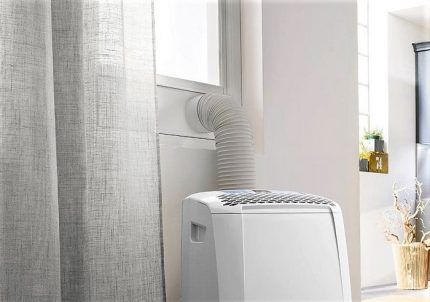
Any option is suitable if the heated air remains outside and does not return to the room through open windows or doors.
Before choosing and installing a mobile air conditioner at home, be sure to think through the installation details.
Conclusions and useful video on the topic
A simple and inexpensive solution for a rented apartment:
Analysis of an installation error - what happens if you lengthen the air duct:
Professional Installation Tips:
According to user reviews and expert opinions, the floor-mounted mobile air conditioner is effective, useful and especially convenient for owners of seasonal housing. It is easy to install and maintain. The only difficulty is in the outlet of the air duct, but thanks to our article you already know how to deal with it.
Tell us about installing a portable air conditioner in your home or office. Share any technological details you know. Please leave comments in the block below, post photos and ask questions about the topic of the article.



